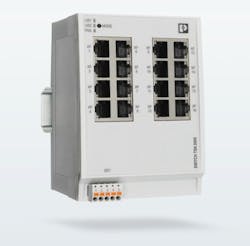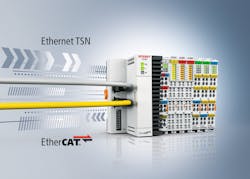As an up-and-coming Ethernet-based technology, Time-Sensitive Networking (TSN) has been generating a lot of excitement in the world of industrial automation. “It holds the promise of having multiple IP-based networks on a network with a degree of time synchronization and determinism,” explains Robert Trask, P.E., North American representative at the EtherCAT Technology Group.
“TSN is not a fieldbus,” he stresses. “It’s a toolbox of functionalities.” Specifically, it is set of IEEE 802 bridging standards being developed and promulgated by the Institute of Electrical and Electronics Engineers (IEEE).”
Stephan Kehrer, senior architect at Belden, says TSN is sometimes misunderstood to “be a completely new communication technology offering real-time capabilities.” Kehrer contends this is not an entirely correct description because TSN has been emerging as a key industrial networking technology precisely because it is not just one new technology for real-time communications.
Yes, TSN does offer a range of new functionality for data transmission—for example, guaranteed bandwidth, real-time guarantees, and redundancy features. “But all of this comes as an enhancement to the well-known and widely established communication technology, namely Ethernet according to Institute of Electrical and Electronics Engineers (IEEE) 802.3 and IEEE 802.1,” explains Kehrer.
Once all the specifications have been developed and promulgated, TSN will be a vendor-independent standard that allows time-coordinated and regular traffic to coexist on Ethernet. It promises to bring together the worlds of information technology (IT) and operations technology (OT) onto a converged network.
It will do so by overcoming the barriers that have been prohibiting IT and OT communications from sharing the same network.
TSN brings together the bandwidth and the determinism needed for the industrial Internet of Things (IIoT). “Devices on a network can communicate with a PLC in real-time and with short cycle times,” says Lessmann. “And at the same time, they can run alongside several parallel IT applications, such as PCs, data analytics, or image recognition with artificial intelligence.”
Understanding the
key functions of TSN
TSN has its origins in the audio/video bridging
(AVB) standards for transferring audio, video,
and other real-time content over Ethernet. “This
laid the foundation for the expansion of Ethernet
into what we now call TSN,” says Tom Weingartner,
technical marketing director at Profibus and Profinet International (PI) in North America.
The next major milestone in the development of the standard was the formation of the TSN Task Group at the IEEE in 2012. “This group spent the next several years putting together a series of specifications that we now consider the TSN toolbox,” says Weingartner.
This toolbox consists of the IEEE 802.1Q 2018 and 802.1AS-2020 standards. “The IEEE 802.1 standards define the mechanisms for time synchronization, traffic priority, and traffic scheduling in Ethernet networks,” says Thomas Brandl at Bosch Rexroth Corp.
“IEEE 802.1 AS, for example, defines Grandmaster clocks that allow all devices on a network to share a common understanding of time with high accuracy—ultimately supporting determinism,” adds Tom Burke, director of global standards at the CC-Link Partner Association.
Then, IEEE 802.1 Qbv defines a time-aware scheduler (TAS), which is essentially a gate driver that prioritizes Ethernet frames based on transmission time. “When urgent cyclic data need to be transferred, TAS temporarily interrupts the transmission of non-urgent traffic,” explains Burke. “As a result, time-sensitive data can be delivered within the reserved time slots for high-priority traffic.”
IEEE 802.1Qbv also optimizes bandwidth usage with a scheduling mechanism based on frame lengths. “When the scheduler receives a message that needs to be transmitted, the overall length of the frame is checked,” says Burke. “If the frame can fit without affecting high-priority traffic, the scheduler sends the information.” If the frame won’t fit, the scheduler either queues the message or, using definitions in IEEE 802.1Qbu and IEEE 802.3br, transmits it in two parts (also known as frame pre-emption).
Besides regulating bandwidth and reserving time slots, rules in IEEE 802.1Qbv also govern the selection of communications paths. “More than one path is defined to build fault tolerance mechanisms,” says Burke. “As a result, latency is minimized, and different data traffic streams can be transferred on a network without delays.”
These TSN mechanisms are now being incorporated into Ethernet chipsets so that automation using those chips can engage in TSN-based communications. The production of Ethernet chips is already underway and, in some cases, completed, reports Lessmann at Phoenix Contact. “TSN requires the necessary hardware support in endpoints and switches,” he adds. “This means that new devices and switches are required.”
The rate of the proliferation of TSN will depend on how quickly chipmakers produce the necessary chips and automation vendors incorporate them into their devices.
Belden recently released its Bobcat Railswitch, a TSN-capable device that can come with link speeds as high as 2.5 Gbit/s. The device supports two time synchronization mechanisms, which make it compatible with existing field devices in brownfield networks and with industrial automation following the IEC/IEEE 60802 TSN protocol.
Bobcat also supports the Time-Aware Shaper (IEEE 802.1Qbv) mechanism with either two or three gate entries, a choice that permits implementing either a two-phase or a three-phase model. The three-phase model promotes convergence. “For example, each of two control protocols can be separated in time within the first two phases, and the Bobcat still allows all other traffic within the last phase,” says Kehrer. Any traffic that might otherwise disrupt the control traffic can be put in this last phase.
For controller-to-controller communications, controls manufacturers are already building boards that offer TSN features. “From our point of view, TSN by itself is not a key technology in industrial networking,” says Brandl at Bosch Rexroth. “Rather, we regard a vendor-independent, standardized application protocol in combination with TSN as the key technology.”
For a standardized protocol, Bosch Rexroth is supporting the OPC UA FX (Unified Architecture Field Exchange) specification. The OPC Foundation has already issued the first release to its members for review, so Brandl expects the protocol to be promulgated soon.
Meanwhile, the new Rexroth ctrlX Core control platform comes with TSN-enabled Ethernet ports and supports OPC UA publish/subscribe communications. “Our recommendation is to start with vendor-independent control-to-control communications based on this,” says Brandl. “TSN and real-time communication capability will follow according to the OPC UA FX specification.” These enhancements will be rolled out in software updates.
Do you really need TSN?
TSN is a technology in need by much of industry.
But it’s not necessary for every industrial
Ethernet network.
One limitation of TSN is that it can be expensive and complicated to deploy. “When there are many nodes, and thus cascaded TSN bridges, TSN suffers from NP [nondeterministic polynomial-time] completeness, where complexity soars with the number of connections,” says Trask. “Every stream requires two TSN connections. Minimizing the number of streams is the only hope for a successful TSN implementation [in such cases].”
A device that might help with this is the EK1000 EtherCAT TSN coupler from Beckhoff Automation. The coupler exploits the ability of EtherCAT to carry the data of many devices in one Ethernet frame and, therefore, in one TSN stream.
“TSN can be used to route an Ethernet frame to an EK1000 and then talk to many other devices on the other end,” explains Trask. “Having few streams greatly simplifies the configuration of a TSN network so much that it is foundational to any real TSN success at the field level.”
Lacking such devices in the near term could mean that cost and complexity may limit TSN to machine automation and discrete-parts manufacturing—at least for now. These applications often require the extremely fast responses, coordinated action, or both that TSN promotes.
Process control loops, on the other hand, are usually much slower acting. “So, for the vast majority of control applications in process automation, there is no need for TSN because the speed of the control loop is easily handled with standard Ethernet,” says Paul Sereiko, director of marketing at FieldComm Group, a standards development organization for process automation.
This should be true even in plants that combine factory and process automation if there is suffiicient bandwidth for non-TSN traffic. “As long as this bandwidth is available, the process instruments need not be burdened with the cost and increased complexity of configuration inherent in a TSN device,” says Sereiko.



